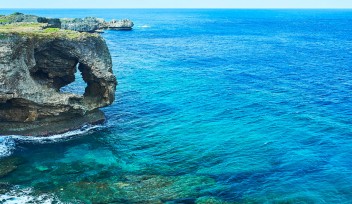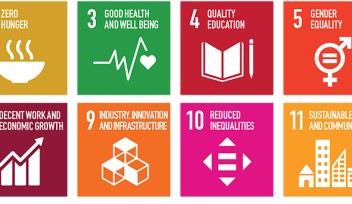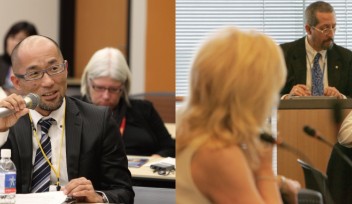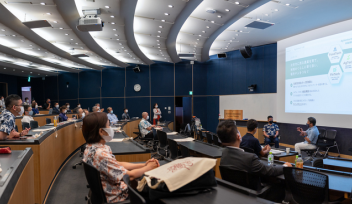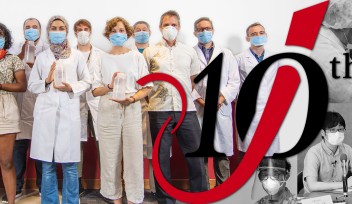OIST domestic economic impact is ¥228 for every ¥100 invested: What's behind it?

To commemorate 10 years since the Okinawa Institute of Science and Technology Graduate University (OIST) was established, the university’s president Dr. Peter Gruss reflects on OIST’s connection to Okinawa in a four-part series focusing on the economy, education, environment, and health, respectively.
The people of Okinawa have long been bridge-builders. Historically, the island was a central hub for Eastern Asia, acting as a trading bridge between China, Korea, Japan and so on. Now, Dr. Peter Gruss, president of OIST since 2017, hopes that the university will facilitate the building of a different kind of bridge that will link this beautiful, subtropical prefecture with the rest of the world. He envisions that, in the next ten years, Okinawa will become the ideal place to establish a science startup, drawing in entrepreneurs from around Japan and overseas. By promoting innovation through science and technology, he hopes to create a sustainable economy for the region—since the groundwork has been laid.
This, Dr. Gruss says, is key to Okinawa, which has the lowest gross domestic product per employee in Japan, building its ways out of its current economic situation.
“The primary contributor to Okinawa’s economy is tourism,” he continued. “We need to bring something to Okinawa that is not already here. On average, the salary earned in a science-based job is almost four times that of one earned in tourism or retail. With new scientific findings, we can develop new science companies. Moreover, in the United States, 75% of all new jobs come from startups that are less than five years old.”
An example of a successful OIST-born startup is EF Polymer. This sustainable agriculture company took part in OIST’s Startup Accelerator Program in 2019, which has been developed in collaboration with OPG/Okinawa Prefectural Government and leverages OIST’s resources, connections, and equipment to allow the teams to launch their ventures here in Okinawa. Whilst EF Polymer’s primary goal is to use a polymer created from organic waste to bind to water and thus make dry land more receptive to plant growth, they are currently working with Okinawa farmers to see if this polymer can make sugar cane grow more productively. In 2019, they took part in the prestigious, green-tech competition, Climate Launchpad and emerged as the Carbon Tech champions.
There are already 28 startups or companies working at OIST and four entrepreneurial teams in OIST's Startup Accelerator Program. However, there are plans to increase these numbers in the near future.
To promote its technologies and to increase investment in startups in Okinawa, OIST is building a network of venture capital firms and corporate partners in Japan and abroad. This has led to a partnership with Beyond Next Ventures, a Tokyo-based venture capital firm and incubator, which is expected to deploy ¥500 million in the next two years to fund startups selected to participate in the program. Furthermore, Dr. Gruss has a vision of an innovation park surrounding OIST’s main campus, which will create an additional 4,000 to 5,000 jobs in advanced technology, high-value industries.
These new science companies won’t just require researchers, but they’ll also need entrepreneurs, business professionals, research contractors, and supporting services. The multiplying factor from direct to indirect economic impact comes from these people who translate scientific breakthroughs into tangible projects.
But OIST’s connection to its island home goes beyond these startups. Significant genomic work has been carried out on economically and culturally important species in Okinawa, like umi-budo sea grapes, mozuku seaweed, kuruma shrimp, and shiikuwasha fruit. These efforts could pave the way for identifying strains of these species that might be resilient to certain diseases, grow faster, or do better in hotter environments, aiding with agriculture and aquaculture efforts.
Other researchers are working with local farmers to grow a strain of Amiromochi rice that was developed at OIST and that is suitable for Okinawa’s climate. Amiromochi rice contains a special kind of starch that can help prevent obesity. Another example is the wastewater treatment system that OIST researchers are designing and testing, to help mitigate the issues caused by wastewater, which is a side effect of the large number of swine farms in Okinawa.
All these efforts are having a broad and substantial impact. An economic report released in 2019 found that OIST generates an estimated ¥228 for Japan’s domestic economy for every ¥100 invested in it. Most of that production impacted the Okinawa Prefecture, generating ¥163 for every ¥100.
“If this impact is projected to OIST’s target size of 300 professors and their units, then OIST alone would be able to generate one third of the GDP needed to make up the difference between Okinawa and mainland Japan,” Dr. Gruss stated.
“OIST’s location in Okinawa is an essential part of its identity and we are committed to our responsibility to deliver benefits locally, nationally, and globally. This commitment is embodied in the OIST Strategic Plan 2020–2030—we want to be the partner of choice for innovation and a catalyst in Okinawa, promoting economic growth and sustainable benefits, addressing problems important to Japanese and global society.”
Related articles
Research Unit
For press enquiries:
Press Inquiry Form










